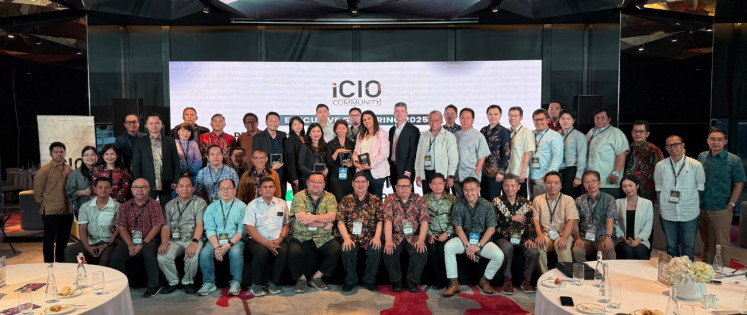Popular Reads
Top Results
Can't find what you're looking for?
View all search resultsPopular Reads
Top Results
Can't find what you're looking for?
View all search resultsBRGM prioritizes the importance of silvofishery and collaboration
Change text size
Gift Premium Articles
to Anyone
 Hartono, the head of the Peatland and Mangrove Restoration Agency (BRGM), engages in an on-site discussion with advisors from the Ministry of Environment and Forestry and the Ministry of Maritime Affairs and Fisheries, as well as experts from Borneo Tarakan University, at a community-owned shrimp farm. (Courtesy of BRGM)
Hartono, the head of the Peatland and Mangrove Restoration Agency (BRGM), engages in an on-site discussion with advisors from the Ministry of Environment and Forestry and the Ministry of Maritime Affairs and Fisheries, as well as experts from Borneo Tarakan University, at a community-owned shrimp farm. (Courtesy of BRGM)
N
orth Kalimantan is one of the nine priority provinces selected by the Peatland and Mangrove Restoration Agency (BRGM) for mangrove rehabilitation. The province has 178,161 hectares of existing mangrove forests and 122,049 hectares of potential mangrove forests.
Mangroves play a critical role in coastal ecosystems, providing habitat for diverse marine species, protecting coastlines from erosion, and storing carbon reserves three to five times greater than tropical forests.
To ensure effective and sustainable restoration of these mangroves, BRGM has initiated collaborations with several ministries, local governments, and universities by inviting advisors from the Ministry of Environment and Forestry, the Ministry of Maritime Affairs and Fisheries, and experts from Borneo Tarakan University (UBT) to discuss and monitor the local mangrove rehabilitation process involving residents of Salimbatu village in Central Tanjung Palas district, Bulungan regency, North Kalimantan.
Many mangrove areas in North Kalimantan have been converted into shrimp farms, which provide income for coastal communities. However, in order to convert the land into shrimp farms, they have to clear the mangrove forests.
As a result, the lack of mangroves led to lower yields because the conversion didn't account for the important role mangroves play in the ecosystem.
To address this, the practice of silvofishery has been promoted, a practice that combines aquaculture with mangrove restoration in coastal areas.
“To restore both shrimp farm productivity and the surrounding ecosystem, replanting mangroves is essential. Mangroves help improve water quality and create an environment that benefits aquaculture,” explained Efransjah, Senior Advisor for Nature Conservation and Climate Change.
Mangrove trees at a North Kalimantan shrimp farm belonging Muhammad Jufri are rehabilitated using silvofishery techniques. (Courtesy of BRGM)
The benefits of silvofishery techniques have been evident for the Pabilung Fish Cultivation Group (Pokdakan), one of the local aquaculture communities in Salimbatu.
"Silvofishery's mangrove planting has had a significant positive impact on our fish and shrimp harvests," said Muhammad Jufri, head of Pabilung Pokdakan. "The fish and shrimp are of excellent quality. They are large, healthy, and reproduce well. The output from our ponds is highly sought after by the community."
However, Muhammad said that it's difficult to find good seeds for fish and shrimp. Pabilung members often have to buy seeds from other regions, which is time-consuming and lowers seed quality. He also said that they require assistance from the Ministry of Maritime Affairs and Fisheries to market their organic aquaculture products with high economic value.
Bagjya Irwansyah from the Ministry of Maritime Affairs and Fisheries said that the area has two types of production, which are shrimp and crab. They are developing a model focusing on environmental protection, particularly in aquaculture zones.
“Regarding seed availability, we are working to streamline the distribution chain, and will involve local governments through fish seed centers,” he added.
Interministerial synergy and cooperation are crucial, as silvofishery activities not only restore the environment but also improve the livelihoods of local communities through aquaculture.
Agus Pambagio, the Minister of Environment and Forestry's Senior Advisor for Climate Policy and Implementation, said that the Ministry of Environment and Forestry, the BRGM, and the Ministry of Maritime Affairs and Fisheries should work together to create policies that help the community. These policies should change based on how well they help people.
“I believe the Ministry of Environment and Forestry, the BRGM and the Ministry of Maritime Affairs and Fisheries should jointly formulate policies that benefit the community. These regulations should evolve based on the positive impacts they have on the people, ensuring that communities benefit from the policies rather than merely adhering to them,” said Agus about the implementation.
The BRGM is actively preserving mangrove habitats through various initiatives, including strengthening regulations for the protection and management of mangrove ecosystems, optimizing forest management and ensuring the sustainability of mangroves in forest areas.
(Courtesy of BRGM)Additionally, it has implemented infrastructure development for mangrove rehabilitation, hydrological improvements and community empowerment through initiatives like the Villages for Independent Mangrove Care and Mangrove Community Schools.
"Mangrove rehabilitation in aquaculture serves two primary functions: to increase mangrove coverage that has been degraded and to prevent the establishment of new shrimp farms by ensuring that the replanted mangroves meet the sustainability needs of existing farms," said Hartono, Head of BRGM.
During his field visit, he expressed his hope in fostering synergy among institutions to ensure the sustainable progress of mangrove rehabilitation and silvofishery practices.
University experts also had a vital role in applying their knowledge for the sustainable conservation of mangrove ecosystems and the welfare of coastal communities. Policymaking must be expedited and formulated collaboratively to ensure that coastal communities reap the benefits of healthy mangrove ecosystems and increased incomes.











